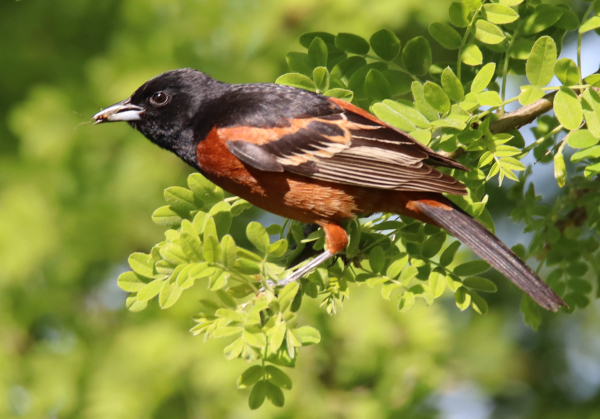
These days it seems I’m surrounded by orioles, but my favorite orioles are definitely the ones that let me photograph them. So on a beautiful sunny morning after a light overnight rain accompanied by a vivid thunder and lightning storm, I headed for Melody’s Grove with high hopes and low expectations. High hopes because there has been a light southeast wind, and a rainstorm overnight might have stopped some migrants, but the BirdCast prediction was for low migration numbers.
Even so, Saturday proved to be best for photographing birds that appeared to have completed their migration. As I approached the first bushes at the south end of the Grove, I could see orioles in action. An adult male Orchard Oriole and a yearling male were doing a rather passive chase, but suddenly the 2 erupted into a spirited clash, or was it an all-out fight. I was in position already, so tried to follow their moving brawl through my viewfinder, taking a couple photos of the process; but alas, the best of the oriole fight photos was terribly out of focus. Oh well.
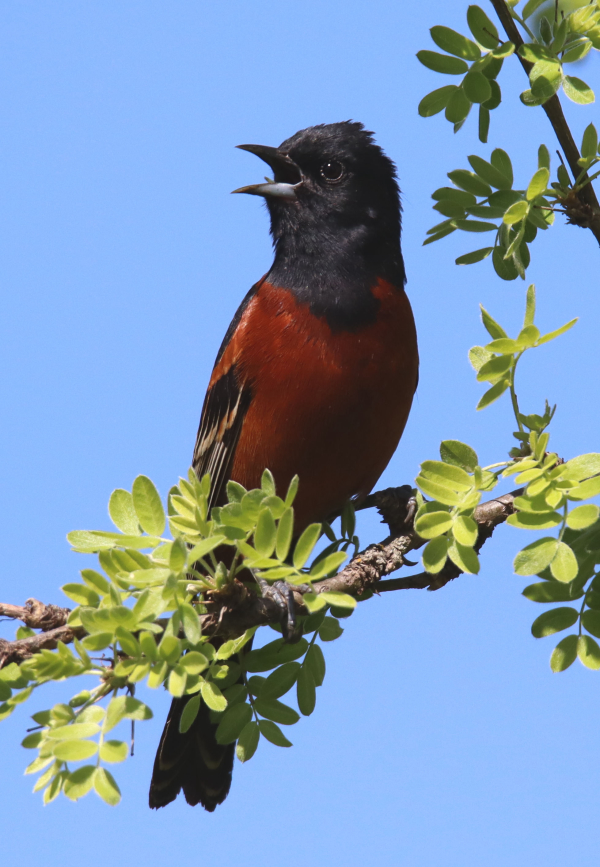
The "clean" scene with the single branch and blue sky background adds a lot to the beauty of this image of a singing male Orchard Oriole. However, the lighting is a bit shaded on the right side of the bird.
|
I have a soft spot for Orchard Orioles though, and they are a species not many people encounter, even birders. But I must live in a super-hotspot for Orchard Orioles, because they are in my yard, at my feeders, down the road at Melody’s Grove, as well as in some of the most remote and unvisited locations in the region. With the potential of photographing either of these males or others, I relaxed and waited.
Although I positioned my mobile blind rather randomly to photograph the oriole altercation, it turned out to be a good location, with some open perches low, at eye level, and overhead. It was also a pretty piece of landscape with bright new green foliage in varied shades of beautiful. The air was as fresh as I could imagine and there was a slow but steady parade of birds during the hours I spent there, all illuminated by the morning sunlight from the east.
As Warbling Vireos and an occasional Red-eyed Vireo made their way along the edge of bushes and trees, along with Yellow Warblers, the males of which were obliged to stop and sing, a few Cedar Waxwings swung by too, diverting my attention for moments. But it was the return of the Orchard Orioles that activated my interest level highest. There seemed to be more than one adult male Orchard involved, which was probably true for the yearling males too. And occasionally a female swung by, including one that actively solicited the males.
It all made for an active couple of hours trying to photograph Orchard Orioles – adult males, yearling males, and females. As usual though, the orioles were playing hard to get. They were very active and within my camera viewfinder often, but almost always behind leaves. Eventually, persistence paid off and I appreciated 4 really good photo sessions where an adult male was hunting and catching insects on the edge of a branch, and while another sang from a couple other open perches.
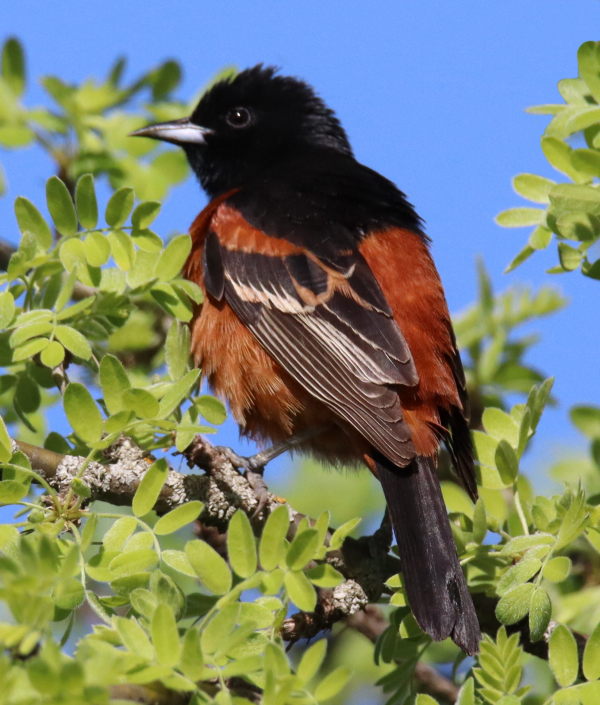
A moment of pause in the open, perhaps to absorb some sunshine, shows the color details of this relatively small oriole species’ plumage.
|
All in all, it amounted to a better series of photos than I’ve had during years of trying to photograph adult male Orchard Orioles. However, the females and yearling males provided no photo opportunities – None! I have many nice photos of females, but I could use a few more images of yearling males. Overall, it’s been an exceptional spring to see yearling males in the area, including my feeding station. Sometimes I have 3 yearling males at my feeders at once, and I know there were at least 4 visiting last Wednesday when I tried to identify individuals among the minimum of 18 orioles – Orchards and Baltimores.
Oriole Tech
I usually use the same camera and lens settings to photograph orioles in relatively dense foliage as I use for migrating songbirds. Saturday I started out with an ISO of 800, which works better under potentially lower light conditions than my usual standard ISO 400. But when the orioles began foraging and singing from the top of bushes and other higher perches with some blue sky in the background, I switched over to ISO 400.
I always use the Av (aperture priority) setting on my camera’s mode dial, in which I set the aperture (f-stop) and the camera automatically provides the corresponding shutter speed, according to the available light conditions in the photo frame. When photographing songbirds among foliage I tend to use an f6 aperture, which I did throughout the morning’s photo session. This practice creates a narrow area in focus, which helps to eliminate as much background clutter as possible by blurring the foliage beyond the focal area. Using an f6 aperture also provides a faster shutter speed, and in the case of the accompanying photographs, the shutter speed varied from 1/800 to 1/2000 to 1/4000 of a second, all of which provided sharp images of the orioles.
Because the Orchard Orioles were rarely in an open location, when they did move out from behind the leaves I sometimes took more than one photo at a time, using the Al Servo setting so I could hold the shutter button down for repeated high-speed photos, a few per second, to take advantage of the moments the bird was in the clear. I prefer taking 1 or 2 photos at a time, but sometimes, I go with the flow and utilize the Al Servo option.
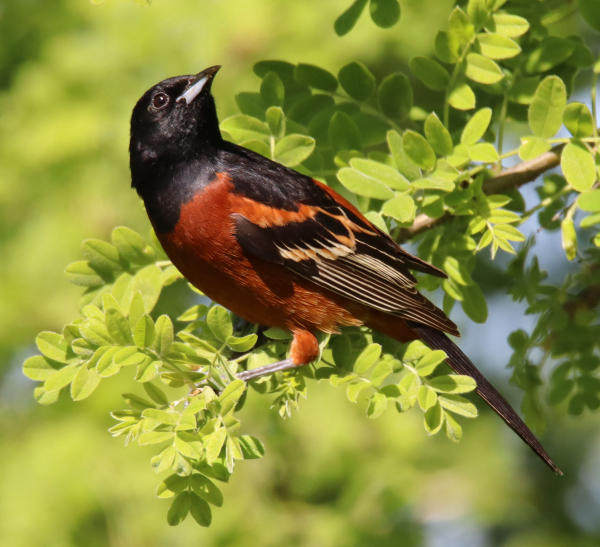
Another point of attention was to use the zooming qualities of my Tamron 600-to-150mm zoom lens. For the photos I selected to illustrate this article, I zoomed in and out from 480mm to 550mm to 600mm. I was lucky to have most of the orioles feeding and singing just above eye level near the top of the bushes, with the exception of the last photo when the singing male was perched higher overhead and a bit to one side.
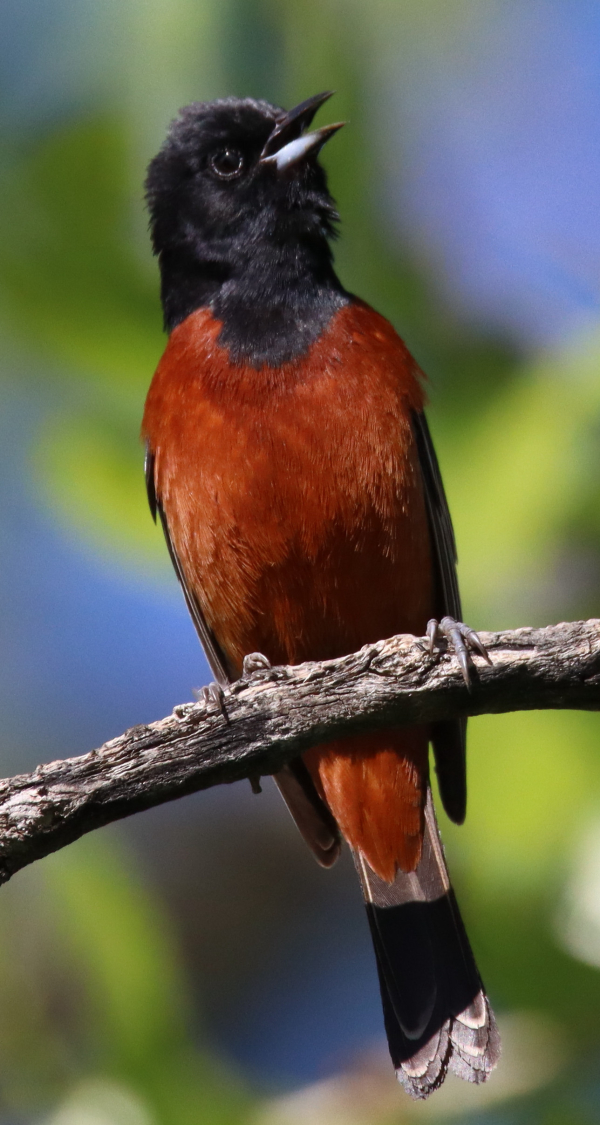
The deep chestnut color of this singing Orchard Oriole is impressive, and the only shadow that shows is on its tail.
|
Adult male Orchard Orioles offer a bit of a challenge because you will soon find that it can be difficult to emphasize the chestnut color of these songbirds. Without appropriate lighting, adult males often look pure black, especially from a distance; only good sunlight will provide the true chestnut color of their plumage. As always, I photograph when the timing is right for the best sunlight, which is mid-morning, and early evening these days in my area. I took most of these images between 9:30 and 11:00am with the sun at my back, which provided optimum natural lighting and colors.
You never know when the time you devote to photographing will provide quality images of birds, or when birds will create an opportunity for you to take good photos of them. The key is to spend the time, don’t give up, pick the time when you have good sunlight at your back for the location you wish to photograph at, and cross your fingers. It all pays off when you have a beautiful spring morning filled with colorful songbirds close at hand, doing what they do in the sunlight while providing you with photo opportunities. It’s so nice when it all comes together like that – it’s so rewarding and uplifting. Good Luck as we begin June, a beautiful month for photography and an active month for bird photographers.
Article and photographs by Paul Konrad
Share your bird photos and birding experiences at editorstbw2@gmail.com